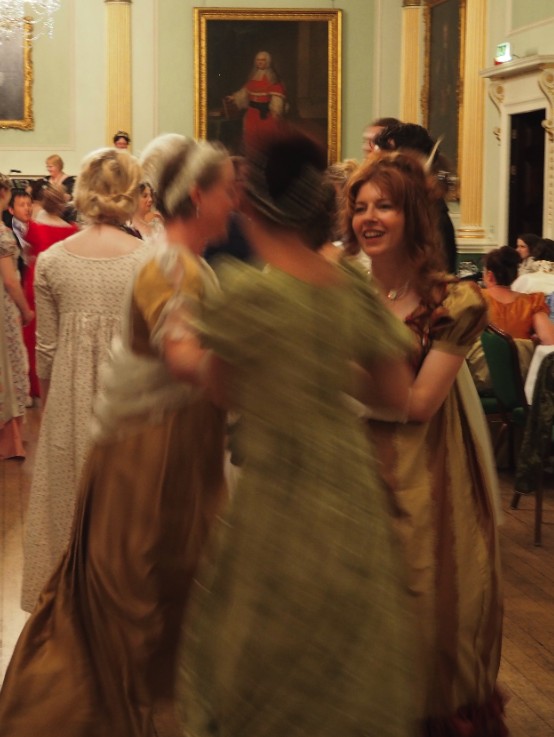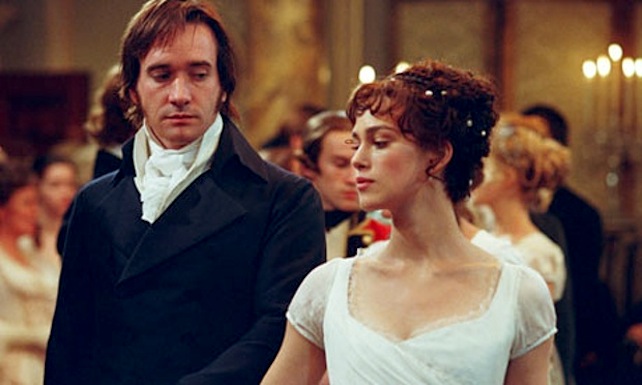In this ongoing series, we ask SF/F authors to describe a specialty in their lives that has nothing (or very little) to do with writing. Join us as we discover what draws authors to their various hobbies, how they fit into their daily lives, and how and they inform the author’s literary identity!
About two years ago, I was standing in a community hall on a hot summer night learning how to curtsy to my Regency dance partner, a guy wearing a black Metallica t-shirt and with an excellent dragon tattoo on his neck. We were making the “honors” which start every Regency dance: a bow or curtsy to your partner and then to the other couples who make up the two lines of dancers. On the surface it was all genteel courtesy, but even then I felt there was something else beneath it: an acknowledgement of a strange and far less genteel alchemy that was about to happen.
Jane Austen called it “the felicities of rapid motion.” Something happens when you dance in concert with other people, when you touch hands and meet eyes for a fleeting moment. I wasn’t expecting it, but a wild joy was about to enter my life.
I was in that hot, stuffy hall for one reason: research. At the time I was midway through writing my latest novel, The Dark Days Club, a Regency supernatural adventure. Now, it is a truth universally acknowledged that a Regency novel must always be in need of a dance scene. Jane Austen built Pride and Prejudice around three dances: the Meryton assembly ball where Lizzie and Darcy first meet, the more informal dance at Sir William Lucas’s, and the Netherfield Ball. Dancing was a crucial part of genteel Regency life and, like Jane Austen, I planned to set some important scenes in the ballroom. However, before I did so, I wanted to gather some firsthand experience.
I have always supplemented my book research with practical experience. In my novels, I aim to create an immersive and vivid world through the senses. In The Dark Days Club, I wanted my reader to walk along Piccadilly with Lady Helen, ride beside her on Rotten Row at Hyde Park, eat Parmesan ice cream with her, and dance with a demon at the famously exclusive club, Almacks. So off I went to a Regency dance class in suburban Melbourne to gather the sights, smells, sounds, tastes, and textures that Lady Helen might experience during a ball.
It was not only a sensory experience that I wanted. I was also curious to understand Austen’s declaration that “to be fond of dancing was a certain step towards falling in love.” As a teenager, I was never fond of dancing, and I was certainly not good at it. I remember shuffling around my handbag at clubs with my girlfriends, and the occasional very bad waltz with my dad at family weddings, but none of my courtships were sealed on the dance floor. They were done over D&D games and in coffee shops; perhaps the modern equivalent of an assembly ball for geeks.
So there I was in that dingy hall, rising from my wobbly honor curtsy and launching into a set: a hop to the right, change your feet and hop back again. It was one of the many steps that I would need to master. In Regency times, most children in genteel households were given dancing lessons. Even the Bennet sisters—ill-educated and financially challenged as they were—would have had an instructor. Dancing was one of the most important accomplishments for both women and men; it was thought that one’s skill at dance was a reflection of the mind and personality. No pressure, then.
Actually, there was enormous pressure on our Regency counterparts. A ball would bring all the young people in a twenty mile or so radius together in a setting where they could have a rare almost-private conversation on the dance floor, and touch one another, albeit through silk or kid leather gloves. It was one of the few activities that men and women did together, the sexes being almost entirely segregated throughout the day. Here was your chance to impress, to admire, to fall in love. To secure your future.
I felt a bit of pressure myself. Not to secure my romantic future—I’m happily married—but to remember the steps. You have to hit your mark so that you are in the right place at the right time, otherwise the figures, the series of steps that creates each part of the dance, deteriorate into giggling collisions. The teacher does call out the steps—a bit like square dancing—but sometimes a body just doesn’t move in the right direction and chaos ensues.
Here came one of the revelations of the night: there is a wonderful sense of community that comes with learning something that is set to music and requires teamwork. I have always been a bit allergic to the idea of teams. Perhaps it is a lone wolf writer thing, or maybe it’s me being an introverted curmudgeon (actually it was enforced team sports at school—blah). Anyway, when we collided we laughed, and when we finally got the dance right, we whooped and high-fived each other. I’ve learned from my research that, much to the displeasure of the 19th century dance masters, our Regency counterparts whooped and hollered in celebration, too.
The dances we learned that night were English contra dances (country dances), performed in two long-ways lines with ladies on the right, gentlemen on the left. They were fast and they were far more robust than the dances I had seen in the movie and television adaptations of Jane Austen’s novels. I was obliterated at the end of the two-hour session. My feet were sore, my calves ached, and my lungs had drawn in more air than they had in years. It was sobering to think how fit those Regency ladies and gentlemen must have been. A dance set—made up of two dances—could last for an hour, and a ball started at around 9 p.m. and went through to about 3 a.m. or 4 a.m. At least six hours of physical exertion. Lydia Bennet, who we know danced all the dances, must have been the equivalent of an Olympic athlete.

I came away from the class with a great store of sensory information for my novel. I also came away with a new passion: Regency dance. I had not moved so joyfully since I was a child, and it was a precious thing to remember that creativity and fun do not only come from sitting in front of a computer and imagining other lives. I dance now as often as possible: at classes, at balls, at festivals, and I sometimes even teach others how to curtsy and set and chassé. Jane Austen was right; I am fond of dancing and I have fallen in love.
Top image from Pride & Prejudice (2005)
Alison Goodman is the author of the international bestselling and award-winning Eon/Eona duology, as well as the acclaimed Singing the Dogstar Blues, the adult thriller A New Kind of Death, and the critically-acclaimed historical fantasy The Dark Days Club. She lives in Melbourne, Australia, with her husband, Ron, and their Machiavellian Jack Russell Terrier, Xander. She is working on Lady Helen’s next adventure. Follow her on Twitter at @AlisonGoodman.










